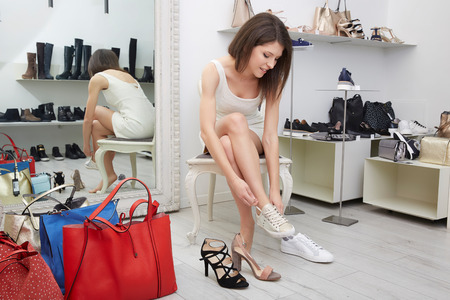
Everyone needs to wear shoes. However, the fit is quite important if you want to be comfortable, be able to do everything you want to do and ensure your feet are healthy. As you may be aware, when your feet are hurting, it isn’t possible to enjoy yourself. Therefore, you need to take care of your feet and buy shoes that fit properly.
In order to buy the correct shoes for your feet, we will cover 10 tips from the Pedorthic Footcare Association on just that.
1. All shoes sizes are not set to a particular standard. Shoes sizes actually vary quite a lot according to the style and manufacturer. For example, if you wear a size 8M in one brand of shoes, you may find that you have to wear an 8N in another shoe brand. So, you shouldn’t solely buy shoes based on the size. It is best to use a size range when shopping for shoes.
2. Before you buy any shoes, you should get your feet measured. In your lifetime, your feet will actually change over time. This means that they will change in both shape and size. Some people even have feet where one foot is a bit longer or shorter than the other or even wider. So make sure that you use your bigger foot when trying on the first side of the new shoes.
Tip: Visit shoe stores that help you by measuring your feet and always wear the socks that you intend to wear with the new shoes.
3. Buy shoes that are well matched to your foot shape. When you do this, then you have a much higher chance of getting a great fit. Take a look at Revitalign for great fitting shoes.
4. Always try on different types and styles of shoes when shopping. You should closely consider how new shoes fit on your feet when judging them. You shouldn’t buy any style of shoes where they feel too tight, loose or certain areas of your foot become irritated. If you get shoes that are too loose or tight, then this would likely result in foot pain over time when you wear them.
5. Get shoes that are the same width as your feet and a little longer. Remember, when you walk or run, your feet would actually get longer.
Tip: Make sure that you have enough space from the end of your longest toe to the end of the shoe. You should leave about 3/8″ – 1/2″ of space.
6. Ensure that the ball of your foot or the widest area of your foot is comfortable in the new shoes. This is important so that your shoes can bend comfortably when you bend your feet. This will make your shoes much more functional and your feet will be more comfortable.
7. Your heels should be as comfortable as possible in the new shoes. You shouldn’t get shoes that are sized too small since this can cause your heels to slip. If you are experiencing heel slippage, then you should try another size or even another shoe.
8. Using orthotics or inserts impact the fit of shoes. When you use foot orthotics or shoe inserts, they use up some of the space where your foot is meant to go. So, if you want to use these, you will need to get shoes with more room inside of them. If you don’t, then the inserts won’t be able to work as they are meant to and you won’t experience a good fit.
9. Select shoes that are correct for your intended activity and how long you intend to do it. Remember, your feet change in different conditions. For example, they will change when you gain weight, after you’ve exercise, in hot weather, when you’re standing, running etc. So, when you’re looking for new shoes, keep in mind that your feet will get a little bigger after these activities.
10. Always walk in the new shoes to ensure that they are comfortable. You don’t need to run in them, however, you should walk in the store a bit before deciding to buy. Remember, shoes have a significant impact on your health and fashion, so be careful when shopping for them.
Tip: Go to stores that provide full service where they have trained staff that know how to measure and fit shoes according to the size, shape, length and width of your feet.
